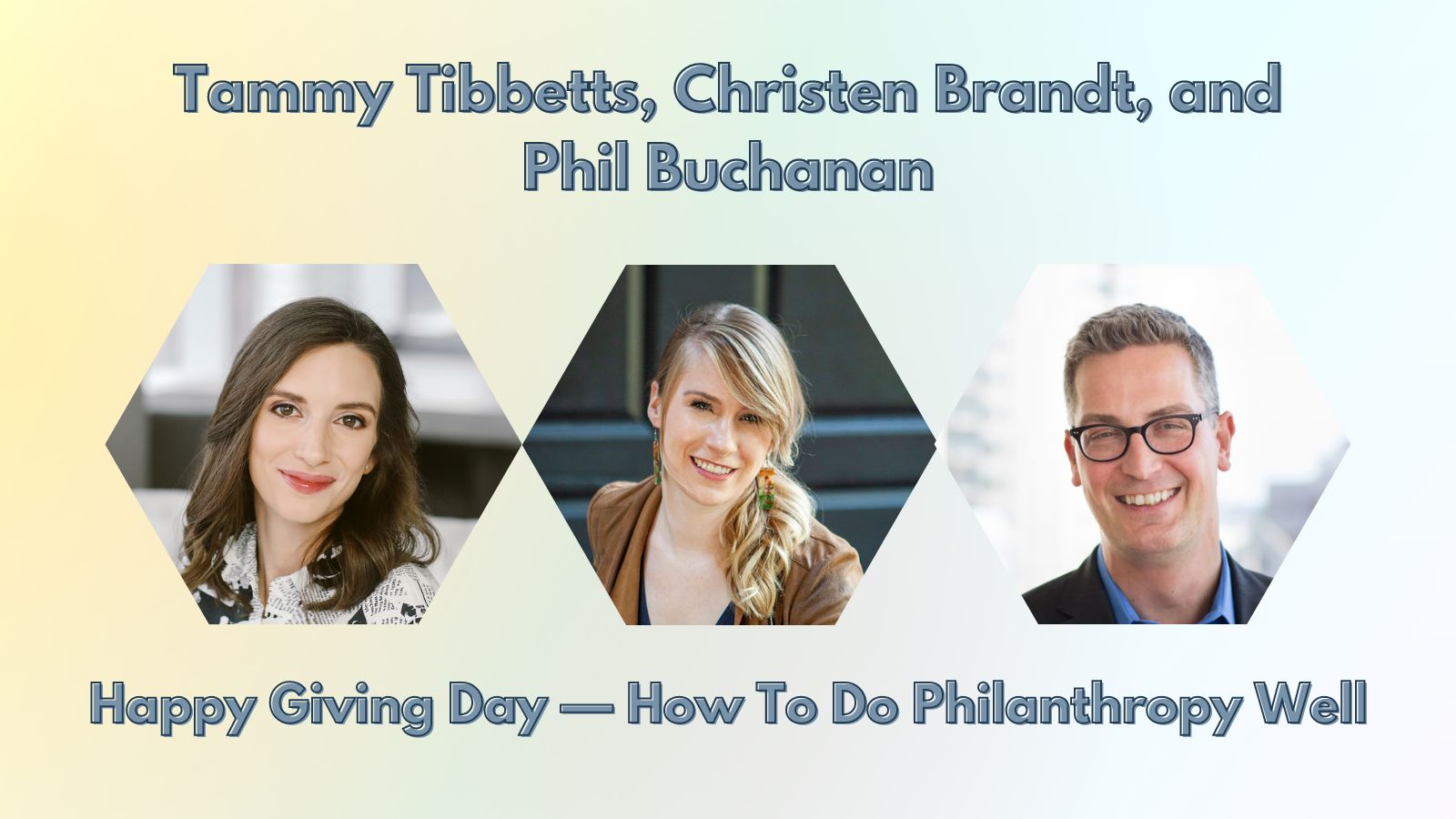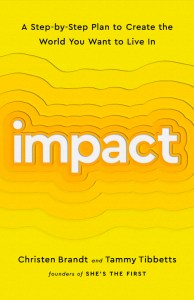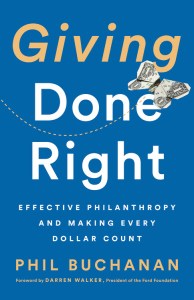Happy Giving Day — How To Do Philanthropy Well

It’s the Tuesday after Thanksgiving, so it must be the National Day of Giving. This is a holiday that follows three powerhouse shopping occasions — Black Friday, Small Business Saturday, and Cyber Monday — and is meant to harness the power of the nation’s generosity.
However, as wonderful as philanthropy seems in the abstract, it can be daunting to put into practice. Where should you donate to make the most meaningful impact? How do you separate worthy causes from online scams? Is the amount of money the organization spends on overhead the best way to determine how effective it is?
To help you really flex your philanthropic muscles, we’ve recruited three experts in the field. The first are Christen Brandt and Tammy Tibbetts, founders of the nonprofit She’s the First and equitable giving specialists whose work has been supported by Michelle Obama, the United Nations, Diane von Furstenberg, and many major brands. They co-authored Impact: A Step-By-Step Plan to Create the World You Want to Live In.
The other is Phil Buchanan, president of the Center for Effective Philanthropy, an 11-time member of Nonprofit Times’ “Power and Influence Top 50” list, and co-founder of YouthTruth, an initiative to help educators and funders accelerate improvements in K–12 classrooms. He wrote Giving Done Right: Effective Philanthropy and Making Every Dollar Count.
Brandt, Tibbetts, and Buchanan agree that giving can be complicated, but all three say that you can be a thoughtful and impactful donor with just a bit of foresight, due diligence, and self-reflection.
[This interview has been edited for clarity and length.]
Let’s start at the most basic level: How should you decide who to give to?
Tammy Tibbetts: For us, it begins with the premise of a north star. We really encourage our readers to unpack their own lived experience and to choose the issue that they are most passionate about. And that’s because there are so many things broken out in our world, and there are so many worthy causes to care about that it can be overwhelming. When we have supporters who are fundraising for She’s the First, or when we are doing so ourselves, we ask them to share the personal reasons why. That is so incredibly effective. So on Giving Tuesday, it’s great for everyone who can give to do so, no matter how small a gift. But if they can go that step further and fundraise on social media and share why they care about the cause they do, they will contribute even more! They will be amazed by how many people are looking to step up and support them.
Phil, there’s such a prevalent perception out there that we should evaluate nonprofits the same way we evaluate a business. But you say that’s exactly the opposite of what we should be doing. Can you explain?
Phil Buchanan: Nonprofits typically are working on the issues that business and government haven’t or won’t address. So saying that nonprofits should operate like a business, what does that even mean? Should they operate like a dry cleaner or Google? Or like Volkswagen when they were cheating on their emissions tests? Because those are all businesses. Then there’s also the fact that nonprofits are in a collaborative context rather than a competitive context, so the strategy is different. It’s not zero sum. If they’re putting their mission first, the homeless shelter actually has to have a good collaborative relationship with other homeless shelters and probably with the substance abuse center in order to make referrals and so on. So you have to embrace the complexity that comes with assessing organizations that are working on complicated, interdependent problems.
Christen, another complexity to add on top of all this is the issue of intent. It isn’t enough to just have good intentions, right?
Christen Brandt: We all want to create good, and the challenge comes in when you don’t know how your actions are going to impact vulnerable communities. A really strong example of this is what we heard from an organization we partner with in Guatemala. A student there had met with some donors who had a really strong connection with her, and the donors decided to leave a $100 bill in the student’s backpack as a way to help support her. The issue is that there are very few ways that a young Guatemalan girl can come across a crisp $100 bill in remote Guatemala, so when her parents found that bill it caused huge, huge issues within the family. They had no idea where this money came from, and neither did she, and they didn’t believe that she had no idea where this money came from. So it led to a lot of issues, including her actually being kicked out of her home for a while. Now this is a very extreme example, but I think it’s illustrative. We need more than just good intentions to ensure we have a positive impact.
So if we can’t rely on just our intent, how do we decide? What are the metrics we should be looking at to make these decisions?
Phil Buchanan: Quantitative measures can be really valuable. If you’re working with gang-involved kids, and you’re trying to recruit them out of gang life, you should look at recidivism rate. That’s a crucial way of understanding the organization’s success. But it’s hard to give one standardized metric that’s going to be relevant for every nonprofit. A lot of people want to talk about the percent that an organization spends on overhead. This comes out of people’s desire to be able to compare across really disparate nonprofits working in different sectors, but you’re never going to be able to do that. Take the example of a food kitchen. You say, “I only want my gifts to go for the food: the broccoli and the chicken, but not for the rent that’s paid for the space in which the food is served, or the salaries to the staff who coordinate the volunteers.” That makes no sense.
Tammy, you and Christen point out that giving money is only one method out of many to make an impact. Can you walk us through the other nonfinancial ways to give back?
Tammy Tibbetts: We encourage people to examine their lives and their resources and make a list so that when they’re approaching nonprofits, they can be upfront about what it is they have to offer. You really want to go into that interaction with the mindset of “Does this meet your needs?” rather than the open-ended question of “How can I help?”, because then you’re asking a nonprofit employee to guide you through this process that you could have done yourself. So we have volunteers who are multilingual and are offering translation services. We have supporters who provide space, which is very expensive if you’re having events in cities. Others host fundraisers or give in-kind contributions. When it comes to volunteering, I prefer to phrase it as pro bono service because it makes you think of the nonprofit as your client and not just this organization that’s lucky to receive your talents and services.
Phil Buchanan: I agree with everything that Tammy said and just want to add that there is a power dynamic involved when you approach a nonprofit, and you need to be aware of that. Sometimes folks at the organization might feel like, “Oh, you want to provide us marketing help? We would love that,” and they’re really thinking, “Oh my gosh, we don’t need that right now.” If you’re a large donor or an institution, you need to be even more aware of that dynamic. For those donors, there’s a bubble of positivity because they’re surrounded by people who are predisposed to tell them what they think they want to hear.
Any other strategies that you recommend when considering giving money?
Christen Brandt: Besides making sure that the organization’s values align with your own, check the people involved. Who sits on their board? Who are they accountable to, and are the people they work with represented in that population? And then see who their other supporters are, who their friends are, who this organization tends to be in community with. I prefer that strategy because the traditional approach to giving to a nonprofit has been looking at their financial statements, looking at their 990s. But most individuals don’t have the expertise to really be able to dive in and interpret a lot of that data.
Tammy Tibbetts: I think that’s a great top three, and I would add something kind of obvious, which is follow through. Do they have an annual report where they have shown that they are accountable? How did they use the funds? How are they defining success? Most organizations will have that on their website.
Phil Buchanan: I agree completely. I get it that nobody wants to get taken, but with a little due diligence, you can make sure that’s not the case. If you make sure that the organization has other credible support or even just that they’re supported by a local community foundation, that will tell you that it’s probably not a scam. And if that organization’s goals overlap with yours as a donor, give them flexible funding so that the talented staff there can make the choices they need to make. For example, maybe a pandemic just hit and they have to move from in-person programming to virtual programming. You don’t want them to have to stop and call you and make sure that’s okay. Be careful not to assume that you know best what others need.
When you feel that pull to be part of social change, where do you start? How can you ensure that your good intentions create a positive impact? How do you focus your scattered efforts? And how do you sustain yourself throughout?
Impact brings you the answers. Drawing on their network and experience as founders of She's the First, Christen Brandt and Tammy Tibbetts show you how to create your own impact strategy, one that fits into your life and allows you to match what you have with what the world needs.
Their guidance, paired with interactive activities, will lead you to identify your North Star, find the right partners, and plug into movements for long-term, systemic change. Equally important, you'll learn how to address biases, practice allyship, and shift power to become more inclusive and effective in your journey.
A majority of American households give to charity in some form or another--from local donations to food banks, religious organizations, or schools, to contributions to prevent disease or protect basic freedoms. Whether you're in a position to give $1 or $1 million, every giver needs to answer the same question: How do I channel my giving effectively to make the greatest difference?
In Giving Done Right, Phil Buchanan, the president of the Center for Effective Philanthropy, arms donors with what it takes to do more good more quickly and to avoid predictable errors that lead too many astray. This crucial book will reveal the secrets and lessons learned from some of the biggest givers, from the work of software entrepreneur Tim Gill and his foundation to expand rights for LGBTQ people to the efforts of a midwestern entrepreneur whose faith told him he must do something about childhood slavery in Ghana. It busts commonly held myths and challenging the idea that "business thinking" holds the answer to effective philanthropy. And it offers the intellectual frameworks, data-driven insights, tools, and practical examples to allow readers to understand exactly what it takes to make a difference.

